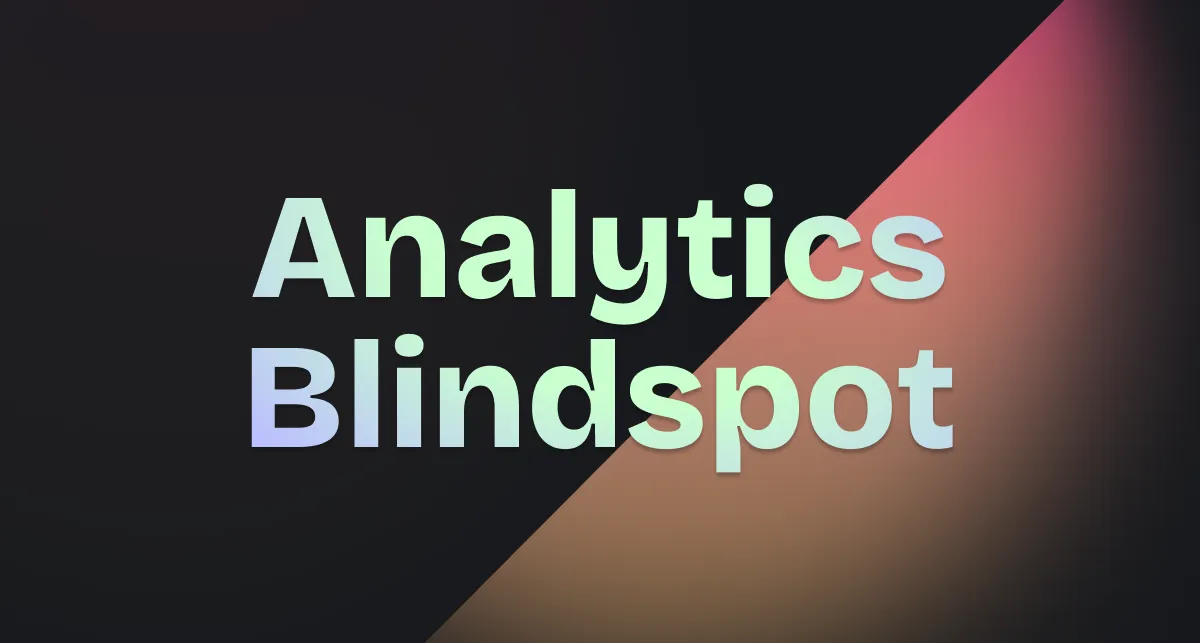The Marketing Analytics Blind Spot - Bots Are Your New Majority Audience
Yesterday, over 1 million website owners did something unprecedented: they blocked AI crawlers from accessing their content.¹
This wasn’t a coordinated effort or industry mandate. These companies independently discovered the same uncomfortable truth-automated agents now comprise over 50% of web traffic,² but their analytics systems couldn’t see any of it.
While their marketing teams were making budget decisions based on what they thought was complete data, the majority of their website’s audience had become invisible.
What’s Really Happening to Web Traffic
Let’s start with the numbers that no one wants to talk about:
- Imperva’s 2025 report: Malicious bots alone represent 37% of all web traffic³
- Netacea’s analysis: “Over 50% of traffic is now automated”⁴
- Cloudflare’s network: Handles 20% of global web traffic, and over 1 million customers chose to block AI crawlers⁵
This isn’t speculation or trend forecasting. These are measurements from the infrastructure companies that actually handle the traffic.
But here’s what makes this a strategic issue rather than just a technical curiosity: your competitors might be the only ones who know what’s actually happening to their traffic.
The Revenue Impact Is Already Measurable
Chegg Inc. didn’t just report declining metrics-they filed a lawsuit citing a 30% traffic loss directly from AI Overviews.⁶ When students can get instant answers from AI systems, they bypass educational platforms entirely.
Ahrefs found that click-through rates for top search positions decline 34.5% on average when AI Overviews appear, with some companies seeing 64% reductions.⁷ This isn’t gradual market evolution-it’s structural disruption.
The trend is accelerating: 13.14% of all search queries now trigger AI Overviews, growing 72% month-over-month.⁸ Google’s AI mode rolls out globally in Q3 2025.
Meanwhile, major publishers moved quickly once they understood the economics. In Cloudflare’s announcement, industry leaders made their positions clear:
Roger Lynch, Condé Nast CEO: “When AI companies can no longer take anything they want for free, it opens the door to sustainable innovation built on permission and partnership.”⁹
Neil Vogel, Dotdash Meredith CEO: “We can now limit access to our content to those AI partners willing to engage in fair arrangements.”¹⁰
The supporter list reads like a media industry directory: The Atlantic, TIME, Fortune, Associated Press, Universal Music Group, Reddit, Pinterest.¹¹ These aren’t technology companies with hidden agendas-they’re content businesses protecting revenue streams.
The Strategic Blind Spots This Creates
When 37% of your traffic is invisible to your analytics, three problems compound quickly:
Budget Allocation Based on Incomplete Data
Your marketing team is optimizing campaigns without seeing the full attribution picture. Traffic that appears to come from “direct” or “referral” sources may actually originate from AI recommendations, leading to systematic misallocation of marketing spend.
Content Strategy in the Dark
While competitors who track AI traffic understand which content AI systems prefer and recommend most frequently, your content decisions are being made without this intelligence. In an environment where AI citation can increase traffic 3% but being overlooked can reduce it 64%, this becomes a high-stakes game.
Competitive Intelligence Gaps
Companies already tracking AI traffic patterns are gaining advantages in search visibility and content positioning that traditional SEO metrics can’t reveal. They know which topics AI systems find most valuable and how to structure information for maximum recommendation probability.
Why This Decision Can’t Wait
I’ll be direct: most companies are following outdated mental models because this change is invisible to standard measurement. But the window for getting ahead of this is closing.
Here’s what we know with high confidence:
- Multiple independent sources confirm bots comprise 50%+ of web traffic
- Real companies are reporting measurable revenue impact (Chegg’s lawsuit isn’t theoretical)
- Major publishers are taking defensive action (1 million+ companies blocking crawlers)
- The trend is accelerating (Q3 2025 global rollout)
What we don’t know yet:
- Exactly what percentage of your traffic is AI-generated
- Which of your competitors are already tracking this
- The optimal content strategies for AI recommendation systems
- The full scope of how customer journeys are changing
But here’s what you can control: implementing measurement infrastructure to reduce this uncertainty before your competitors do.
The Decision Framework
This is what I’d call a low-cost, high-intelligence decision with asymmetric upside:
What it requires: Marketing team coordination plus technical implementation (roughly 1 day)
What you risk by waiting:
- Continued misallocation of marketing spend
- Lost competitive intelligence about AI-driven discovery patterns
- Missed optimization opportunities for content AI systems prefer
- Attribution gaps that prevent accurate ROI measurement
- Strategic blindness to customer journey evolution
What you gain by moving first:
- Complete attribution accuracy for budget allocation
- Content intelligence about AI system preferences
- Competitive positioning advantage before Q3 acceleration
- Customer journey insights invisible to competitors
The implementation can be done incrementally-start with basic tracking, expand based on what you learn. It’s reversible if needed, but the intelligence advantage compounds over time.
The Practical Next Step
Recommended action: Direct your marketing team to implement AI traffic tracking.
- Step 1: Basic GA4 configuration for immediate visibility into AI traffic sources Free Guide
- Step 2: Track what pages are AI agents requesting from your website. Need help? Reach out on my calendar Calendar Link
The economic model underlying digital marketing has shifted. Most companies don’t realize it yet because the change is invisible to their measurement systems. But the data is clear, the trend is accelerating, and the companies moving first are gaining sustainable advantages.
The question isn’t whether AI traffic will impact your business-the evidence shows it already has. The question is whether you’ll measure and optimize for this reality before or after your competitors establish their advantages.
Your marketing team already has the capability to implement this. They just need the directive to prioritize it.
References
¹ Cloudflare. “Cloudflare Just Changed How AI Crawlers Scrape the Internet-at-Large.” Press Release, July 1, 2025.
² Netacea. “Hackers vs Crackers: Key Differences and Why They Are Both Extremely Dangerous.” 2025.
³ Imperva. “2025 Imperva Bad Bot Report: How AI is Supercharging the Bot Threat.” 2025.
⁴ Netacea. “Hackers vs Crackers: Key Differences and Why They Are Both Extremely Dangerous.” 2025.
⁵ Cloudflare. “Cloudflare Just Changed How AI Crawlers Scrape the Internet-at-Large.” Press Release, July 1, 2025.
⁶ Reuters. “Chegg to lay off 22% of workforce as AI tools shake up edtech industry.” May 12, 2025.
⁷ Ahrefs. “AI Overviews Reduce Clicks by 34.5%.” 2025.
⁸ Semrush. “Semrush Report: AI Overviews’ Impact on Search in 2025.” 2025.
⁹ Roger Lynch, Condé Nast CEO, quoted in Cloudflare Press Release, July 1, 2025.
¹⁰ Neil Vogel, Dotdash Meredith CEO, quoted in Cloudflare Press Release, July 1, 2025.
¹¹ Cloudflare. “Cloudflare Just Changed How AI Crawlers Scrape the Internet-at-Large.” Press Release, July 1, 2025.

Step-by-step implementation guide for tracking AI crawlers and human traffic from 15+ AI platforms. Includes GA4 configuration, advanced tools, measurement frameworks, and executive reporting templates for immediate deployment.
